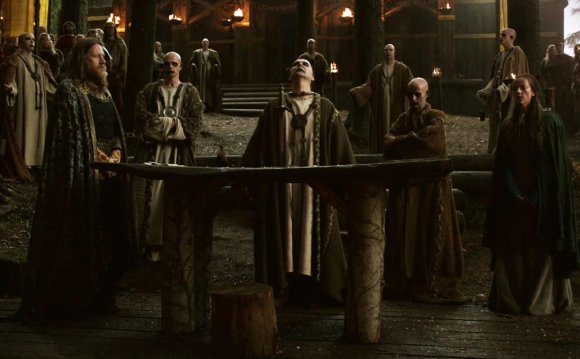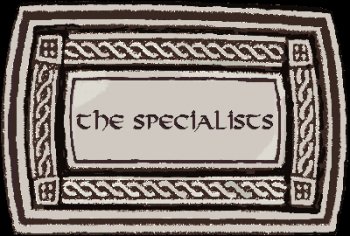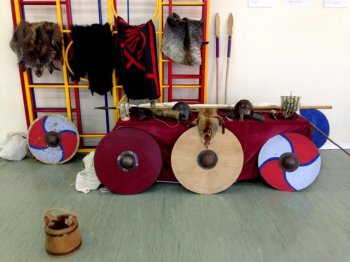
 The Specialists
The Specialists
1. Vikings were very clean people (at least by comparison to other people at the time!).
2. A Viking's most treasured weapon was his sword. They were handed down generations via inheritance, were often named and could be inscribed with runes by talented smiths to magically increase their power.
3. Viking longships could carry at least sixty men.
4. The nursery rhyme 'London Bridge is falling down' could be linked to a Viking named Olaf the Stout who fixed cables from longships to the bridge and pulled it into the Thames.
5. Viking pastimes included a Norse ball game called Knattleikr - which means ... erm ... ball game!
6. Onion soup was fed to the injured to identify injuries that were beyond treating! Stinky!
7. Vikings played Piggy in the Middle with rolled up bearskins.
8. Most Viking boots were made of goatskin.
9. Buttons hadn't been invented yet so toggles, clasps and brooches were used.
10. Some Vikings attached thrusting spikes to the centre of their shields to adapt them for offence as well as defence.
11. Everybody attended a big meeting called (wait for it) The Thing!
12. There were no toilets on longships!
13. Vikings navigated using bearing dials; astronomy; lodestones, sunstones and by releasing captured birds when they thought they were near land.
14. Erik the Red was so violent even fellow Vikings objected; exiling him from both Norway and Iceland.
15. Vikings believed in two groups of Gods - the Aesir (pronounced "Eye-Ear") and the Vanir.
16. Thursday is named after Thor, God of Thunder.
17. Byelaws in England are called that because in Viking times 'by' meant village. So Grimsby was a village where a Viking called Grim lived and Kirkby is the village with the church.
18. Vikings loved riddles; sagas; stories and songs.
19. On average, Vikings would live to around their forties.
20. Children would be considered adults by the age of twelve!
21. The Viking diet was good and varied, accounting for their height not dissimilar to our own.
22. There were three main classes in Viking society: Jarls (earls) who were noblemen; Karls (average, free Vikings) and Thralls who were slaves.
23. King Cnut (Canute) was the first Viking king of England.
24. Viking runes were shaped using angular strokes for ease when carving into wood.
25. Vikings' teeth were ground down by the grit in their bread.
26. Many trades had workshops with three or four craftsmen of different ages and skill working to become Master Craftsmen.
 27. The famous Jelling Stone was raised by King Harald Bluetooth in the 960s.
27. The famous Jelling Stone was raised by King Harald Bluetooth in the 960s.
28. Norse housewives' rights were better than those of some women in later periods. They held the keys to the longhouse; commanded slaves in the master's absence and could divorce for reasons like their husbands showing too much chest hair!
29. Viking houses in England were made of wattle (which means wooden sticks).
30. There were two meals a day - day meal and night meal!
31. Prow carpenters for longboats were paid well, acknowledging their great art which is evidence of Viking sensibilities sometimes forgotten.
32. Silver armbands were popular amongst the rich.
33. Battles started at a distance with projectiles like arrows and rocks from slings.
34. Ordeals were a test of bravery to sort out arguments by picking stones out of hot water or carrying hot iron for nine paces.
35. Vikings loved brightly coloured clothes, using woad for blue; weld for yellow and madder for red.
36. Norse boats were very well made and were often named.
37. A baldric was a shoulder strap to carry a sword.
38. The Danegeld was an example of Viking extortion; promising "protection" for gold.
39. The historical Macbeth submitted to Viking King Cnut in 1031 along with Malcolm and Iehmarc.
40. Vikings were great traders, taking bronze scales with them on trips to weigh money and metals.
41. Vikings wanted to die in battle in order to make it to Valhalla - the Norse afterlife for brave fallen warriors.
42. In the year 1000 at the Iceland Althing, King Olaf ensured the peaceful adoption of Christianity by Vikings. He was later sainted for it by the Roman Catholic Church.
43. Viking women died earlier than men due to the dangers of childbirth, usually by the age of 35.
44. Fish was eaten throughout the year and smoked in roofs for preservation with herring, haddock, cod and trout being common.
45. In 939AD Vikings from Dublin conquered the whole country and England was as one.
46. Rich Vikings (chieftains and Jarls) enjoyed imported wine from Germany, ate from metal plates, employed skalds for epic poetry, rode horses and had wives described as pretty, slender and wise.
47. In winter, Vikings brought their cattle and poultry into their longhouse (which they could share with children, slaves and their own parents)!
48. Vikings believed that good health came from observing their Norse religion and that medicine angered the gods - which explained the Fall of Rome.
49. Blood sports were popular including bear baiting and horse fighting or for poorer folk cock fighting.
50. Vikings grew the flax plant for spinning into linen.
51. Norsemen made torches from marsh grass called lyssiv for lighting the home.
52. Longships could travel up to 200 km per day!
53. Although swords were double-edged, the seax (a knife worn by all free Vikings) were single bladed.
54. The first Viking raid was Lindisfarne in 793.
55. Vikings believed in fate and thought the three Norns ruled over past, present and future.
56. The Danelaw was the part of England where Danish (or Viking) law held sway.
57. Bone combs were stronger than antler ones.
58. York was a great trading settlement called Jorvik.
59. Norse people used whale and seal skin to make strong ship's rope.
60. Vikings took scary figureheads off their longship prows when sailing in friendly waters so as not to offend the gods.
61. Buckets must have held a lot more significance than now and there were probably several wooden ones about the house.
62. The famous 12th Century Lewis Chessmen are carved from Walrus Ivory to look like Vikings but we can't be certain that Vikings played Chess. Hnefatafl is a similarly strategic game they enjoyed though.
63. If chainmail or iron helms were too expensive, some Vikings opted for padded leather tunics and leather helmets.
64. Before (and sometimes even after) Christianity took hold, Viking chieftains were sent into the afterlife on a burning longship with many of his possessions around him.
65. Wielded overhead at maximum velocity, Dane Axes were capable of cutting through iron helmets and down through a skull, coming to rest at around about the teeth!
66. Vikings may have travelled by camel on trading expeditions to far flung places.
67. Writing gave a man power. Runes were believed to have come from Odin himself when he sacrificed himself on Yggdrasil - the world tree and wrested them from the underworld, tearing them from the roots of the tree.
68. Great trading settlements included Jorvik; Novgorod and Kiev in modern day Russia; as well as Birka in Sweden; Kaupang in Norway and Hedeby in Germany (then Denmark). Trades routes stretched at least as far as Constantinople (Istanbul - then called Mikkelgard by Vikings) and Jerusalem.
69. Norse craftsmen used bow lathes for working amber and jet and pole lathes for turning wood.
70. There were three main festivals: Vetrarblot in mid October; Jolablot or Midsvetrarblot in mid January and Sigrblot in April.
71. Christian Vikings believed that building bridges and roads helped your soul go to heaven.
72. Skipton was named so by Vikings as the sk sound was easier to say. Before then it had been Shipton (literally ship-town). Most sk words are Viking like: skim; scatter, scab, screech, skirt, skill etc.









